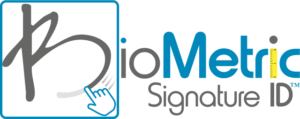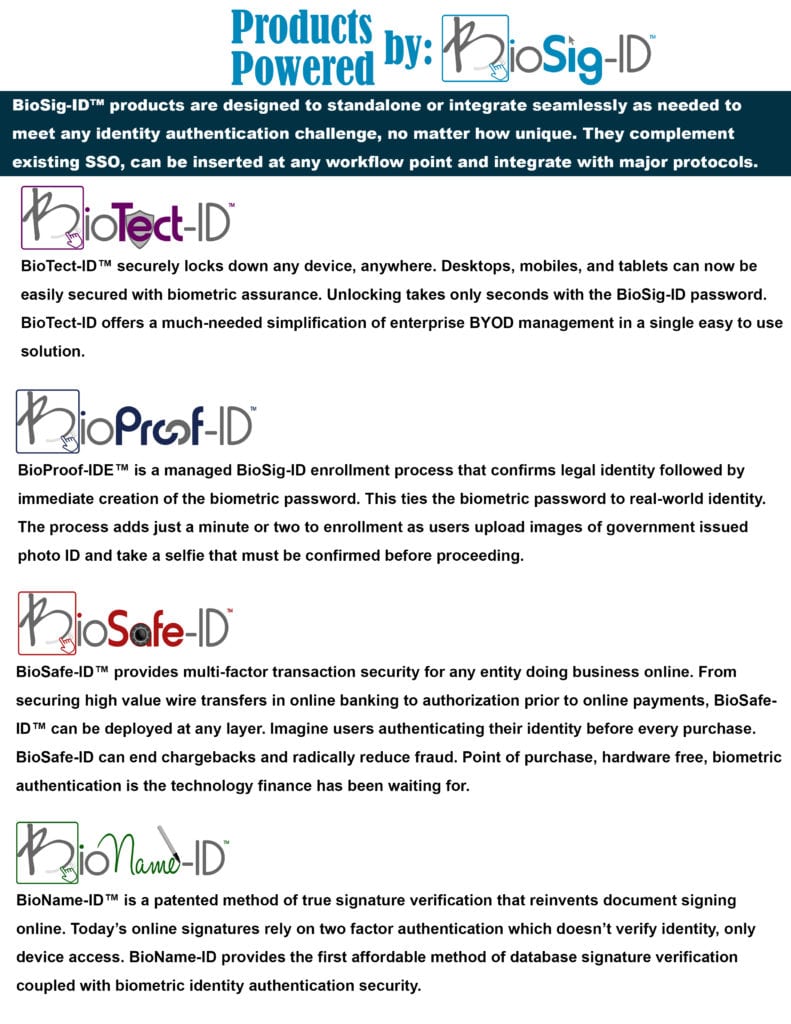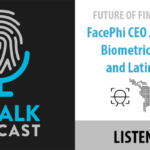
As the biometrics landscape continues to evolve, various next generation authentication modalities are emerging to better best serve the specific security and convenience needs of relying parties. Among these new modalities is gesture biometrics, like those offered by Biometric Signature ID, a leader in this new frontier of identity and authentication.
Susan Stover, Director of Digital Content, FindBiometrics, sat down with Jeff Maynard, CEO and Founder, Biometric Signature ID. The conversation starts with an overview of the company’s history, and Maynard goes on to differentiate gesture biometrics as a modality, delving into its many benefits and use cases. The discussion turns to what the future holds for Biometric Signature ID, Maynard providing a preview of his company’s next big solutions: BioTect-ID and BioSafe-ID.
Read the full interview with Jeff Maynard, CEO, President and Founder, Biometric Signature ID:
Susan Stover, Director of Digital Content, FindBiometrics: Can you please give our readers a brief background on Biometric Signature ID?
Jeff Maynard, CEO and Founder, Biometric Signature ID: Absolutely! The company started doing business as Biometric Signature ID in 2007, and we were basically in stealth mode really until the middle of 2011 after we completed independent testing because it was a new form of biometrics – called gesture biometrics. We needed to confirm to clients and prospects alike we were confident that our false positive or negative rates met or exceeded national standards. Our results confirmed we were 3X greater accuracy than NIST guidelines. It was then we knew we were onto something great! So, that really gave us a kick start and we started selling commercially late 2011.
I got the idea of starting this company when I was President of Security Biometrics, a small publicly traded company. I had two different divisions: one in the United States and the other in Canada. We were developing an electronic prescribing system for physicians. Upon obtaining the North American rights for a point-of-service machine, where you enter in your credit card and you sign at checkout but unfortunately, it was not accurate.
One day, in front of the DEA in Virginia, they were worried about prescriptions that were being done in triplicate for all the controlled substances, all the pain meds. They said they would really love to roll our solution out into the internet but were worried it would open Pandora’s Box unless they were able to verify the identity of the physician. We presented our hardware device solution and they said, you know that’s not bad but we have 600,000 physicians in the US who could utilize this for controlled substances, but each office needs three devices and at $400 a device, we can’t afford this solution but if you could come up with a software biometric where we didn’t require a device or needed distribution and maintenance then come back and talk to us.
This was an epiphany moment. I looked at my CTO, who was a Vietnamese guy, brilliant in math and I said, do you think we can do this? He said I think we can build this, so we started out on this odyssey.
I completed a reverse merger of the company, took a buyout and I created BSI. For two years I funded my CTO to work in my upstairs office and we created what we have today.
The first thing was making sure we created a working model and submitted our patents. Today we have two issued patents on the technology. In those two years, we outsourced 18 projects to four different groups in Vietnam. We were ready to launch.
Our commercial start happened when I wrote a white paper for higher education application to stop students online cheating. We attracted one of the largest public universities who invited us to address their board. They loved it and we ended up in weeks performing a 30-day successful pilot with them and that gave us our start.
To date the majority of our business is in higher education which coincided with the Higher Education Reauthorization Act and the explosion of online classes, The Department of Education requires students taking the class is the same one receiving the credit and a degree. 6000 colleges and universities in the United States had to comply to maintain their academic accreditation. We were in the right place at the right time and today we’re a market leader in higher education with ID verification of students. With 14 million uses, over a million users and 200 plus locations our user adoption is expanding every day.
The company has enjoyed great growth year after year and achieved profitability. At their request we re-opened our Series A round so one of our two institutional investors could triple down their initial investment, which is unusual. It’s always a good sign. Our sales have more than doubled our investments which is a very good story. Now we are seeking our next round of capital raise.
FB: Well, that’s just amazing Jeff. Congratulations on that! In our industry right now, we’re seeing a huge explosion of different biometric modalities. What would you say makes Biometric Signature ID’s gesture-based solutions unique from other biometric solutions?
Jeff Maynard, CEO and Founder, Biometric Signature ID:
BSI’s core technology is our gesture biometric authentication flagship software called BioSig-ID™. Our solution requires no hardware or software downloads and authenticates users by capturing their unique movements (gestures) as they draw a four-character password with their pointing device; a finger or mouse. Four drawn characters are enough to biometrically identify legitimate users with 99.78% accuracy while stopping imposters who already know the password with 99.97% accuracy.
BioSig-ID forms a biometric template from the user’s distinct gestures attributes of angle, speed, length, order, width and more. All future logins are compared to this template. Over time, BioSig-ID keeps learning to maintain an accuracy rate that is 300% beyond NIST biometric standards.
BioSig-ID is a Multi-Factor Authentication (MFA) solution that can be deployed at any layer to gate access to any content or asset. It includes a suite of forensic and reporting tools that detect fraud attempts and provide real-time warning of potential data crimes in progress.
BioSig-ID is dynamic and relies on gestures, not static physical characteristics. What makes BioSig-ID revolutionary is it resets and revokes like a typed password. The password characters and drawing patterns can be changed at any time. No other biometric can be reset. Because of this, static biometrics present an ongoing privacy risk to user identity and data. If you are using these to log in or provide access to devices or assets this is now a significant issue. If we are ever hacked, we can simply replace this with a simple re-enrollment. You simply write a different series of numbers or letters. By contrast, you can’t grow new fingerprints, or a new face.
A big market issue with many solutions is deployability and ease of use. These however, are our specialties. We can deploy in 30 minutes using common security languages like SAML 2.0 or learning management systems. Client user surveys confirm a 98% positive experience with 48% of the first-time users finding its “entertaining”. Because of this we built a web-based contest where hackers can try to spoof Mom and win $500.00. In four years none have succeeded but everyone has fun!
Rapid deployment, lightweight API, a 5 second log in and affordable licensing put BioSig-ID within reach for any company or institution that requires the highest identity assurance to secure its devices and online operations. Credential hacks are the single most vulnerable point of entry. BioSig-ID™ puts an end to that risk.
We have a forensics division where we catch the bad guys in real-time or by historic searches using products that we’ve created ourselves called suspicious relations reports and or history, activity, location, time, risk scoring, and this is a big differentiator for us.
With accuracy comparable to other biometrics, coupled with the elimination of hardware or software downloads, BioSig-ID is the future of virtual and device authentication.
FB: That leads me to my next question, Biometric Signature ID’s solutions are used in a wide range of vertical markets including banking and finance, healthcare, enterprise systems, and like you mentioned education and government. Where are you seeing the most growth?
Jeff Maynard, CEO and Founder, Biometric Signature ID: I look at two things: one is activity and one is growth. Let’s talk about activity. Most of the activity is in the financial services side and with associations. There’s a hundred of professional associations with tens of thousands to millions of members that are trying to address deniability and verifiability of constituents or members obtaining certifications and assessments. Associations want to do this remotely using online classes and we’re ideally suited. We are expecting a large spike in association business, with enterprises, SSO partners and healthcare interests escalating.
Higher education sales levels are increasing due to the increasing Higher Education Act compliance and audits due to high volume of student aid fraud at six billion dollars a year. This means improper payments to people who are claiming they are students, who are not students and we’re working with our clients to help catch those fraudsters. We’re able to help our clients reduce their risks save in some cases near millions of dollars because if we catch these students, they don’t have to pay them their financial student aid. This is this is a big deal.
FB: It’s such a unique solution. Before, you talked about multi-factor authentication which is at a critical point for security yet we’re still not seeing mass deployment across networks, whether that’s because of cost or confusion. How is Biometric Signature ID addressing these challenges?
Jeff Maynard, CEO and Founder, Biometric Signature ID: We believe that many stakeholders are still evaluating. There’s still a lot of people who are stuck in the traditional belief that any choice will involve huge resources to implement and some are worried about the user experience, mostly on the financial side. Some are also concerned about GDPR and California’s new Consumer Privacy Act making some of them afraid to make a move for fear they’re going to make the wrong choice in a solution.
We’ve had situations where we’ve been evaluated as one of six biometrics and we end up being tied for number one, but they still don’t want to move because they just want to evaluate the market for the next six months. There’s a lot of confusion in the market from vendors making unrealistic claims, it is hard to separate fact from fiction. One tip is to ask a vendor to see their “independent testing” results proving their claims as most cannot produce any results. Or worse many will claim we have so much data we mine our own data. The problem with this is can be bad data and you can’t draw any conclusions and the client may make very bad decisions. Some companies are not yet willing to place a bet on a vendor’s solution for fear it will be obsolete within two years.
Our position, however, is that once they see our ease-of-use and simple deployability, we are multi-factor authentication MFA out of the box. Our product mix delivers an end-to-end solution for all their security needs then they’ll consider us as the safe bet for coming years. We can stay the course.
FB: That leads completely into my next question, can you walk me through the deployment process for BSI Solution?
Jeff Maynard, CEO and Founder, Biometric Signature ID: There’s a couple of ways we do this. In higher education we’re integrated with the leading eight learning management systems as a plug-in or as a building block. It’s very easy and takes maybe 2 hours and supports clients with over 100,000 users who use us multiple times daily. Our record so far is we deployed to 17,500 users in less than 3 days with only 4 help desk tickets.
The next case is we do custom integrations using common security market language like SAML 2.0 or LTI or others. For example, we just did 35 providers for an association and we budgeted 2.5 hours for each of those integrations and it took us a month to do all that which is incredible. But in all cases we were able to place BioSig-ID before any event where you wish to authenticate identity before the users can gain access to a device or application or virtual app asset, test, quiz, exam etc.. In enterprise you want to do it while they’re logging into their Windows workstation and use it to either replace the Windows login or augment it. In other situations, you might want to use it for an onboarding method using one of our products called BioProof-ID.
We just announced a partnership for on-boarding with Mitek (MITK) and their MiSnap™ technology for document verification and facial recognition. Once users are verified they complete the BioSig-ID enrollment. Once they’re enrolled in our system it’s near impossible anyone is going to be able to duplicate your password because of the way you draw your password or letters. Basically, you don’t need to do the onboarding document verification or facial recognition again.
FB: And what’s next for Biometric Signature ID?
Jeff Maynard, CEO and Founder, Biometric Signature ID: What’s next is a couple of things. We’re focused on accelerating our forensics.
And launching our next exciting new product called BioTect-ID™ One of the platforms we’ve chosen to help us with this launch is FindBiometrics.
BioTect-ID™ is a revolutionary solution we are launching. This is going to be one of our biggest products because it securely locks down your devices with our gesture biometrics. Desktops, mobiles, and tablets can now be easily secured with biometric assurance. Unlocking takes only seconds. Imagine a simple way to secure your desktops, with no more sharing of passwords. it’s going to stop the imposters from getting into your PC and uncovering all the wisdom, client lists, videos and all the other personal and corporate information that is contained within. We’re looking at a very big uptake of BioTect-ID as it fills a significant market need and it’s using our proven BioSig-ID technology used over 14 million times. BioTect-ID offers a much-needed simplification of enterprise BYOD management in a single easy to use solution.
Our exciting solutions that all use gesture biometrics are listed below:

FB: That’s amazing. That definitely makes you very unique and it sounds like there’s just so many exciting things going on right now for your company. Thanks so much for answering those questions.
We’re looking forward to learning more about these solutions and covering it through FindBiometrics.








Follow Us